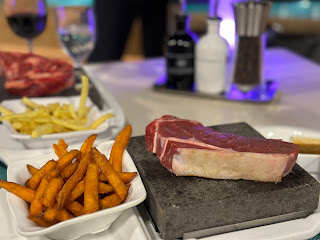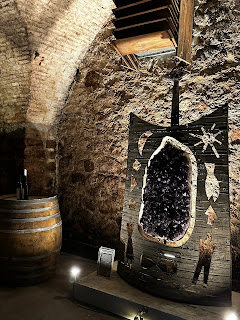Our tour in Montevideo on Tuesday took us into one of the wine regions of Uruguay. Agriculture is the third largest industry in the country, after cattle production and tourism. Along with being the breadbasket and the rice paddy for much of southern Brazil and Argentina, Uruguay is in the Southern Hemisphere Wine Belt, in company with New Zealand, Australia, Argentina and Chile.
We drove out to the Juanico winery, one of the largest and most established in the country. They have vineyards in the central part of the country, where we were visiting, as well as toward the Atlantic coast. On the way, our tour guide asked if anyone knew the origin of Montevideo's name. Of course no one did, so she told us: The land in and around the city is very flat, with the exception of one hill of 500 feet in height. Apparently when the Spanish arrived to look it over, someone yelled 'I see a hill!' And that's how it got the name: Monte = hill, Video = I see. This may or may not be true, but it's a great story.
The winery's land was originally owned by Jesuit monks from Europe who planted vineyards to produce wine for celebrating Mass as well as other agricultural products to support the Indians who had converted to Christianity. In the 1760s, the Spanish government exiled the Jesuits and began transferring their property, and in 1830 the land was transferred to Don Francisco Juanico. There was a period in the 20th century when it was owned by smaller family groups who came from the eastern part of Uruguay, and in 1945, after WW II, as part of the payment of debt owed by France for the agricultural products Uruguay sent during the war, a plot of vineyard was given the authorization to plant the grape varietal used to make Cognac, and to make the Cognac in the French method. It is known as Cognac de Juanico. This authorization lasted for 60 years, until 2005, and although none can be made now, Juanico still has some of the Cognac in both bottles and barrels. In 1979 the Deicas family took over 307 hectares of vineyards including the Cognac plot, and now they concentrate on producing quality wine for export.

 |
| The five wines on our tasting menu. |
 |
| Caesar salad |
 |
| Just to keep everyone clean, we were all given a classy bib to wear |
 |
| Steaks on the 'grill' and fries. The sides come cooked, but I put my vegetables, and even my fries, on the rock to heat them up as they cooled. That worked out well, too. |
 |
| Cheesecake for dessert |











No comments:
Post a Comment